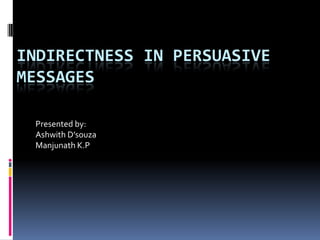
Indirectness in persuasive messages
- 1. INDIRECTNESS IN PERSUASIVE MESSAGES Presented by: Ashwith D’souza Manjunath K.P
- 2. Indirectness in Persuasive Messages Persuasive messages generally are written in the indirect order. While they do not necessarily involve bad news, their goals often run contrary to the reader’s current wishes. The mind-set of the resistant reader must be changed before they can be successful. Achieving this change requires indirectness.
- 3. General advice about persuasion Adaptation is especially important in persuasive messages. Moving your reader from an uninterested to interested, cooperative one is a major accomplishment. To achieve this we need to follow this •Know your readers •Choose and develop targeted reader benefits •Make good use of three kinds of appeals •Make it easy for your readers to comply
- 4. KNOW YOUR READERS •Understanding your reader is critical. •Thinking from the readers point of view is critical. •We need to know about their values, interests and needs. •Company specializing in direct-mail acquire this kind of information using variety of research techniques, demographic and psychographic information.
- 5. Choose and develop targeted reader benefits No one is persuaded to do something for no reason. People cab be motivated by tangible or intangible rewards. Prefer intrinsic benefits over extrinsic benefits Turn your product features into reader benefits. Use scenario painting to help readers visualize themselves enjoying the benefits of the product.
- 6. Make good use of three kinds of appeals Aristotle identified three kinds of persuasive appeals: Based on logic (logos) Based on emotion (pathos) Based on character of the speaker (ethos) All three kinds come into play in every persuasive message. But as the writer of a persuasive message , we will need to think carefully about how to manage these appeals and which ones to emphasize given your intended audience.
- 7. Make it easy for your readers to comply Be sure to make the requested action clear and easy Sometimes writers focus so much on creating persuasive appeals that they put insufficient thought into making the requested action as clear and easy to perform as possible There are two main types of persuasive messages in business Persuasive requests Sales messages
- 8. Persuasive Requests There will be many times in your work life when you will need to make persuasive requests. Whether written to internal or external readers, requests that are likely to be resisted require a slow, deliberate approach. You must persuade the reader that he or she should grant the request before making the request. More specifically, you must present facts and logical reasoning that support your case. And you must do it convincingly. Such a presentation requires that you begin by developing a plan .
- 9. Determining the Persuasion Developing your persuasive plan involves three interrelated tasks: Considering your own goals for the message Considering your readers’ needs and interests Deciding upon a persuasive plan A special persuasive plan is the problem-solution strategy, which uses the common-ground technique.
- 10. Gaining Attention in the Opening The opening sets the strategy and gains attention Attention is needed to get the reader in a mood to receive the persuasion What you write to gain attention is limited only by your imagination. The opening of a problem-solution message describes a problem that you and your readers share.
- 11. Presenting the Persuasion We should help convey the points with convincing details. Since we are trying to penetrate a neutral or resistant mind, we need to make good use of the you-view point. We need to pay careful attention to the meanings of our words and the clarity of our expression.
- 12. Making the request clearly and positively Follow the persuasion with the request Word the request for the best effect Do not use a negative tone Be positive The request can end the message or be followed by more persuasion.